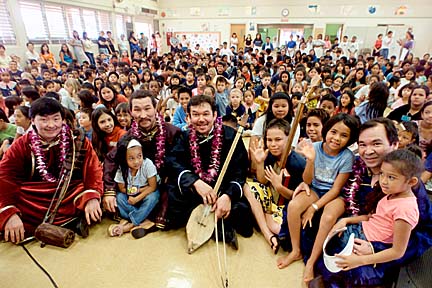
DENNIS ODA / DODA@STARBULLETIN.COM
Huun-Huur-Tu, throat singers from Tuva, shared their traditional music yesterday with Waiau Elementary School students. They test the limits of vocal ingenuity, carrying two musical lines simultaneously. Musicians Andrei Mongush, left, Alexei Sarlygar, Sayan Bapa and Kaigal-ool Khovalyg posed with the children after their performance.
Tuvan vocalists
impress studentsThe throat singers from Asia will
give two concerts at the East-West Center
Hundreds of students sat cross-legged on the cafeteria floor as Andrei Mongush opened his mouth to let loose a deep vibrating bass tone, then added a dainty flutelike melody dancing above it, simultaneously from his throat.
The art of "throat singing," one of the world's oldest musical traditions, blew in from the South Siberian Republic of Tuva to Waiau Elementary School in Pearl City yesterday. A quartet known as Huun-Huur-Tu used vocal ingenuity and handmade instruments to paint a soundscape of their pastoral homeland, from trilling birds to the patter of horse hooves on the steppes.
"At first I thought it was an instrument, and then I realized it was actually them singing it," said Rachel Ellis, a fifth-grader who was spellbound by the singers' ability to sing different tones at once. "It was cool because you've never heard that before."
The troupe is in Hawaii for the first time and will give two sold-out concerts at the East-West Center this evening. The musicians visited Waiau yesterday at the request of school counselor Dennis Nishihara, with help from the University of Hawaii Cultural Extension Program.
"I remember seeing a documentary on (the public television program) 'Nova' years ago, and I got all excited about what they do with their voices," Nishihara said. "I wanted the whole student body to experience them."
The Tuvans are a traditionally nomadic, Turkic-speaking people who live in a mountain basin north of Mongolia where they raise cattle, reindeer, camels and other animals. Some of their songs are 1,000 years old, according to Sayan Bapa, a co-founder of Huun-Huur-Tu.
Starting at about age 5, Tuvan singers learn to exercise additional muscles in their throat that are typically dormant in other cultures.
"It's like a game for us," Bapa told the kids, who pressed for an explanation of just how it was done. "We see our fathers doing it. We try and we listen. We listen and we try."
Jaunty tunes, featuring the Tuvan versions of a banjo and viola, with actual horse hooves rapping on one musician's knee, kept the audience's heads bobbing.
"I've heard many different types of music, but this is the best so far," 10-year-old Keku Pratt declared after the performance, adding that it made him want to visit Tuva, which is part of the Commonwealth of Independent States. "I wish I was there."
The visit helped reinforce the school's effort to embrace differences among cultures and to promote the arts.
"It is important for our kids to know that this is real," said Marcia Omura, a fifth-grade teacher. "It's not just something in a book or National Geographic. This is the sort of thing that helps build your capacity to care about others."
Students had prepared for the visit by studying the geography, politics and beliefs of the Tuvans. Hawaiian immersion students, who make up roughly a fifth of the 600 students at Waiau, performed a welcome chant of their own.
"There's a lot that connects us with them," Nishihara said, noting that the Tuvans share the Hawaiian belief that "there's mana in everything." He said the visit helped students understand how "things can be both the same and different."
Jim Phelps, Waiau's music coordinator, said he feels lucky to be at a school that values the arts at a time when such subjects can get short shrift.
"Music is a uniting force," he said. "It's unfortunate that so many programs get cut. All the things that made me excited about going to school are now considered extra stuff."
